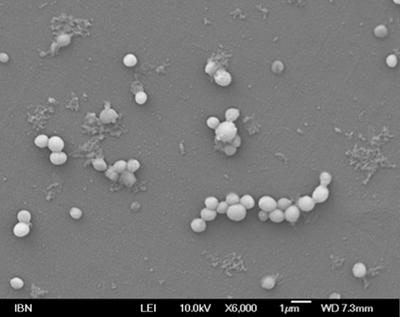Researchers from IBM in the US and the Institute of Bioengineering and Nanotechnology in Singapore have developed an antimicrobial hydrogel that can break through diseased biofilms and eradicate drug-resistant bacteria upon contact.
The scientists say the synthetic hydrogel, which forms spontaneously when heated to body temperature, is the first to be biodegradable, biocompatible and non-toxic, making it a suitable tool to combat serious health hazards facing hospital workers, visitors and patients.
Traditionally used for disinfecting various surfaces, antimicrobials can be found in traditional household items such as alcohol and bleach. However, treating drug-resistant skin infections or infectious diseases is more challenging as conventional antibiotics become less effective and many household surface disinfectants are not suitable for biological applications.
IBM Research and its collaborators developed a remouldable synthetic antimicrobial hydrogel, consisting of more than 90% water, which, if commercialised, would be suitable for applications such as creams or injectable therapeutics for wound healing, implant and catheter coatings, skin infections or even orifice barriers.
The remouldable synthetic antimicrobial hydrogel consists of more than 90% water
Able to colonise on almost any tissue or surface, microbial biofilms – the adhesive groupings of diseased cells present in 80% of all infections – persist at various sites in the human body, especially in association with medical equipment and devices, and contribute significantly to hospital-acquired infections.
Despite advanced sterilisation and aseptic techniques, infections associated with medical devices have not been eradicated. This is due, in part, to the development of drug-resistant bacteria.

Through the precise tailoring of polymers, the researchers designed macromolecules that combine water solubility, positive charge, and biodegradability characteristics. When mixed with water and heated to body temperature the polymers self-assemble, swelling into a synthetic gel that is easy to manipulate. This capability stems from self-associative interactions that create a ‘molecular zipper’ effect in which the short segments on the new polymers also interlock, thickening the water-based solution into re-mouldable and compliant hydrogels. Since they exhibit many of the characteristics of water-soluble polymers without being freely dissolved, such materials can remain in place under physiological conditions while still demonstrating antimicrobial activity.
We were driven to develop a more effective therapy against superbugs due to the lethal threat of infection by these rapidly mutating microbes
“This is a fundamentally different approach to fighting drug-resistant biofilms. When compared with the capabilities of modern-day antibiotics and hydrogels, this new technology carries immense potential,” said James Hedrick, Advanced Organic Materials Scientist at IBM Research. “This new technology is appearing at a crucial time as traditional chemical and biological techniques for dealing with drug-resistant bacteria and infectious diseases are increasingly problematic.”
When applied to contaminated surfaces, the hydrogel's positive charge attracts all negatively charged microbial membranes, like powerful gravitation into a blackhole.
“We were driven to develop a more effective therapy against superbugs due to the lethal threat of infection by these rapidly mutating microbes and the lack of novel antimicrobial drugs to fight them. Using the inexpensive and versatile polymer materials that we have developed jointly with IBM, we can now launch a nimble, multi-pronged attack on drug-resistant biofilms which would help to improve medical and health outcomes,” said Dr Yi-Yan Yang, Group Leader, Institute of Bioengineering and Nanotechnology, Singapore.
This research was recently published in the journal, Angewandte Chemie.




